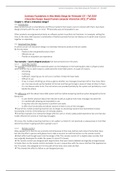Samenvatting
Summary Foundation in New Media Design for Premaster CIS
This is a summary that covers all the chapters for the exam of Foundation in New Media Design. It gives a good overview of all the chapter that you need to know with a lot of good examples from the book. Good luck!
[Meer zien]





